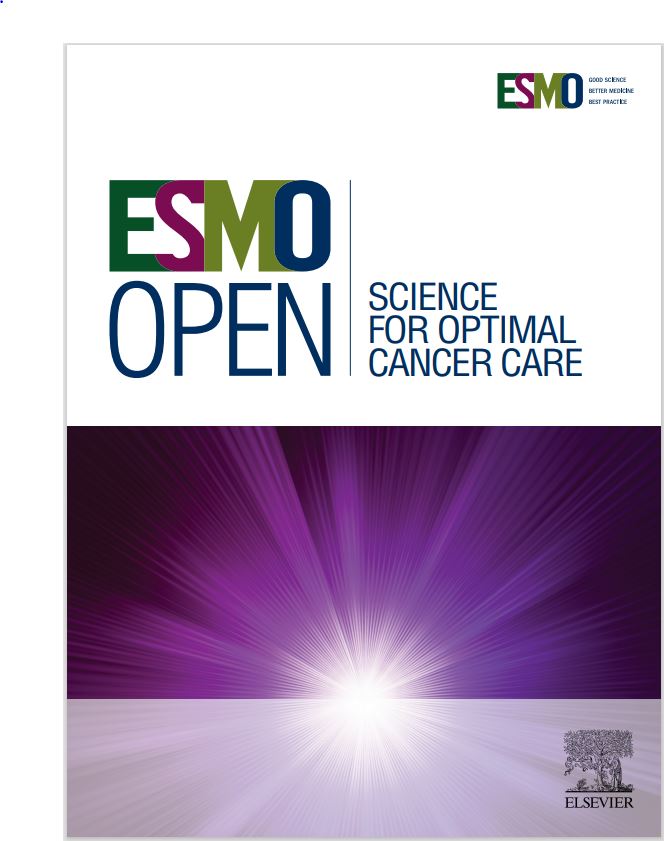奥拉帕尼作为铂难治性生殖细胞肿瘤的拯救治疗:IGG-02 II期试验
IF 7.1
2区 医学
Q1 ONCOLOGY
引用次数: 0
摘要
背景:晚期生殖细胞肿瘤(gct)多次复发或耐药后的治疗选择是有限的。奥拉帕尼是一种聚(adp -核糖)聚合酶(PARP)的抑制剂,PARP是一种参与DNA修复的酶。在这项原则证明的开放标签、单组、II期试验中,奥拉帕尼300 mg每日2次用于复发/难治性转移性生殖细胞癌患者[IGG-02研究(NCT02533765)],患者的资格包括在高剂量化疗或至少两种不同的顺铂为基础的方案后失败。结果2015年9月至2019年2月,纳入18例患者,中位年龄39岁(22-61岁)。7例患者出现严重不良事件(ae)。无部分缓解,5例(27.8%)病情稳定(SD)持续3、4、4、7和43个月,13例(72.2%)病情进展。种系DNA修复图谱显示,只有一个brca1突变病例与持续4个月的SD相关。长期服用奥拉帕尼的患者(43个月)出现骨髓增生异常综合征(MDS),并伴有影响PPM1D的致病性突变。结论索拉帕尼作为单一药物在重度预处理的GCT患者中无活性。未来的PARP抑制剂研究应在较少预处理的GCT患者中进行分子分析,以支持更好的患者选择。本文章由计算机程序翻译,如有差异,请以英文原文为准。
Olaparib as a rescue treatment in platinum-refractory germ-cell tumors: the IGG-02 phase II trial
Background
Therapeutic options for patients with advanced germ-cell tumors (GCTs) after multiple relapses or resistant disease are limited. Olaparib is an inhibitor of poly (ADP-ribose) polymerase (PARP), an enzyme involved in DNA repair.
Patients and methods
In this proof-of principle open-label, single-arm, phase II trial of olaparib 300 mg twice daily in patients with relapsed/refractory metastatic germ-cell cancer [IGG-02 study (NCT02533765)], patient eligibility included failure after high-dose chemotherapy or after at least two different cisplatin-based regimens.
Results
Between September 2015 and February 2019, 18 patients, with a median age of 39 years (range 22-61 years) were enrolled. Severe adverse events (AEs) were observed in seven patients. There were no partial responses, five cases (27.8%) with stable disease (SD) lasting 3, 4, 4, 7 and 43 months, and 13 (72.2%) progressive disease. A germline DNA repair profile panel showed only a BRCA1-mutated case associated with an SD lasting for 4 months. The long-lasting patient on olaparib (43 months) experienced a myelodisplastic syndrome (MDS) associated with the onset of a pathogenic mutation affecting PPM1D.
Conclusions
Olaparib as a single agent demonstrated no activity in heavily pretreated GCT patients. Future studies with PARP inhibitors should be planned in less-pretreated GCT patients based on molecular analysis to support better patient selection.
求助全文
通过发布文献求助,成功后即可免费获取论文全文。
去求助
来源期刊

ESMO Open
Medicine-Oncology
CiteScore
11.70
自引率
2.70%
发文量
255
审稿时长
10 weeks
期刊介绍:
ESMO Open is the online-only, open access journal of the European Society for Medical Oncology (ESMO). It is a peer-reviewed publication dedicated to sharing high-quality medical research and educational materials from various fields of oncology. The journal specifically focuses on showcasing innovative clinical and translational cancer research.
ESMO Open aims to publish a wide range of research articles covering all aspects of oncology, including experimental studies, translational research, diagnostic advancements, and therapeutic approaches. The content of the journal includes original research articles, insightful reviews, thought-provoking editorials, and correspondence. Moreover, the journal warmly welcomes the submission of phase I trials and meta-analyses. It also showcases reviews from significant ESMO conferences and meetings, as well as publishes important position statements on behalf of ESMO.
Overall, ESMO Open offers a platform for scientists, clinicians, and researchers in the field of oncology to share their valuable insights and contribute to advancing the understanding and treatment of cancer. The journal serves as a source of up-to-date information and fosters collaboration within the oncology community.
 求助内容:
求助内容: 应助结果提醒方式:
应助结果提醒方式:


